💡 Key Insights
📈Frequency of research resistance:
A significant part of respondents frequently encounter resistance to UX research, with over half rating the resistance at 5 or above on a 7-point Likert scale.
💡 Common Objections:
The primary stakeholders’ objections to UX research include concerns about product schedule impact, budget constraints & general resistance to change.
👀UX professionals believe that these objections are often rooted in lack of understanding, time pressure & organizational culture.
💥 Hardest objections to overcome:
UX professionals consider resistance to change to be the hardest objection to overcome, followed by budget constraints & product schedule impact.
🌳Evolution of challenges:
The impact of research on product schedules becomes less of a primary issue for more experienced professionals.
As organizations grow, internal resistance to change becomes a more significant issue.
For UX professionals with more experience, resistance to change not only becomes a more common issue but also increasingly harder to overcome.
✋ Stakeholders’ resistance to change:
Stakeholders’ resistance to change tends to be stronger in larger organizations, and is more frequently reported by UX professionals with more years of experience.
🔄 Overcoming objections:
Jump to the list of Tips and strategies from UX professionals for overcoming stakeholders’ objections to research and securing their buy-in.
Although UX maturity has grown in recent years, research teams still face significant resistance. Some stakeholders believe research is unnecessary, others cite tight budgets, and some fear it will delay projects.
Due to these challenges, resistance to UX research remains a common issue globally.
To address this, we surveyed UX professionals to find out why stakeholders resist investing in research and what strategies help to win them over.
In this report, you’ll find:
- Quantitative insights from our survey about the state of resistance to research among different UX roles and companies
- Statistics about what stakeholders’ objections to research teams encounter the most
- Community-sourced advice for dealing with each specific objection to research
- Tips and strategies from UX professionals for dealing with stakeholders’ resistance to research
- A downloadable UXR Cheat-Sheet to support your next battle with stakeholders’ resistance
➡️ How other UX professionals deal with stakeholders’ resistance?
Jump to Practical tips from UX experts for overcoming stakeholders’ objections to research and securing their buy-in.
The State of Resistance to Research
Our study aimed to gather insights on how experienced UX professionals handle stakeholders’ objections to research. We also wanted to collect statistics on who raises these objections and why.
Additionally, we share our experiences working with companies at different stages of research investment and analyze discussions in major UX communities.
Questions we asked UX professionals experiencing objections to research
Here’s what we asked about:
- If so, and how frequently do they encounter resistance to UX research,
- Which objections from stakeholders they face most often,
- Who raises these objections,
- According to their experience, what are the main reasons for these objections,
- Which of these objections do they find to be the hardest to overcome.
A significant part of respondents frequently encounter resistance to UX research, with over half rating the resistance at 5 or above on a 7-point Likert scale. Lower levels of resistance were less common, with only 2.8% rating it a 1.
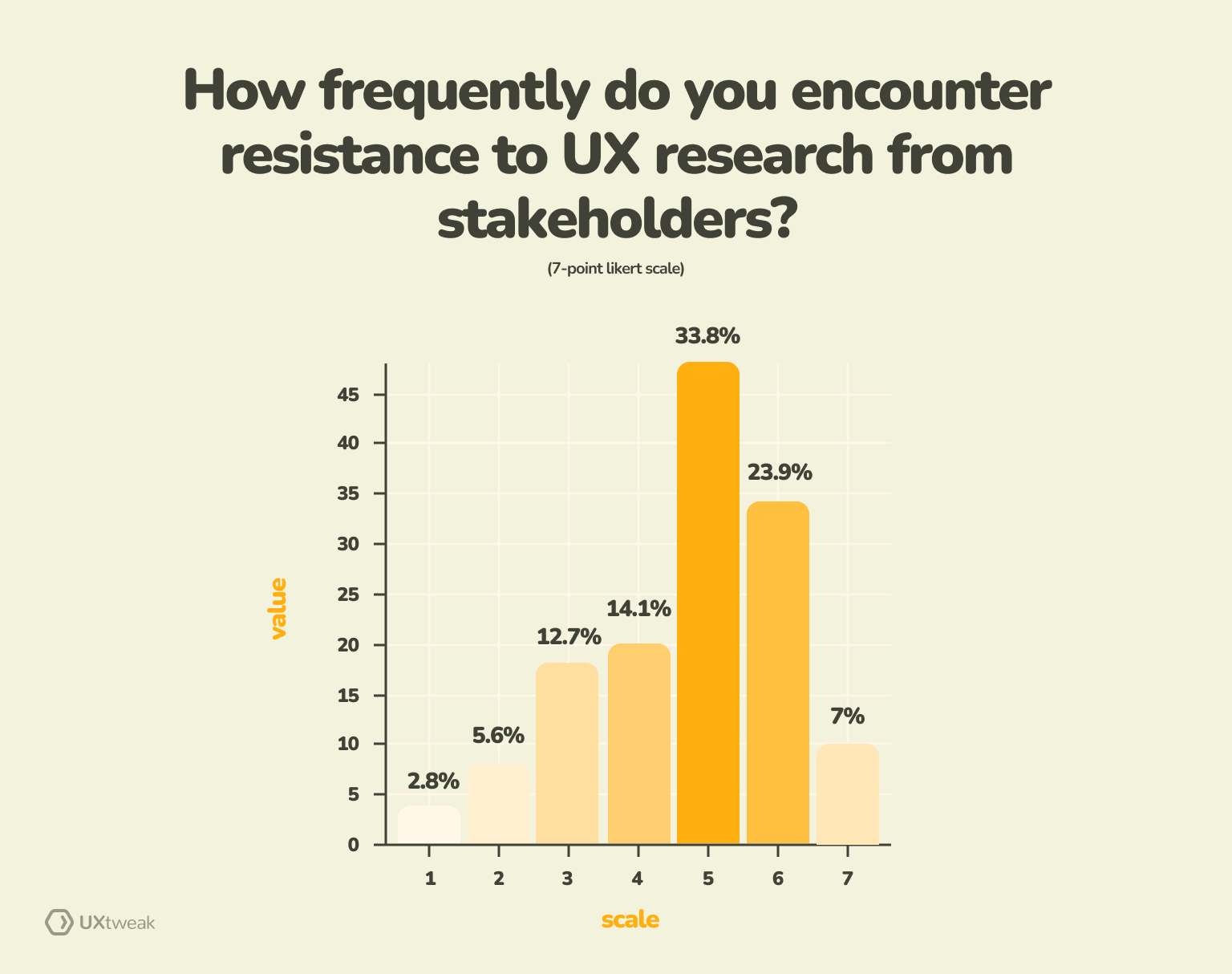
Most common stakeholders’ objections to UX research
In addressing objections to UX research, the most frequently cited challenges include product schedule impact (18.2%), budget constraints (15.5%), and stakeholders’ resistance to change (15.1%).
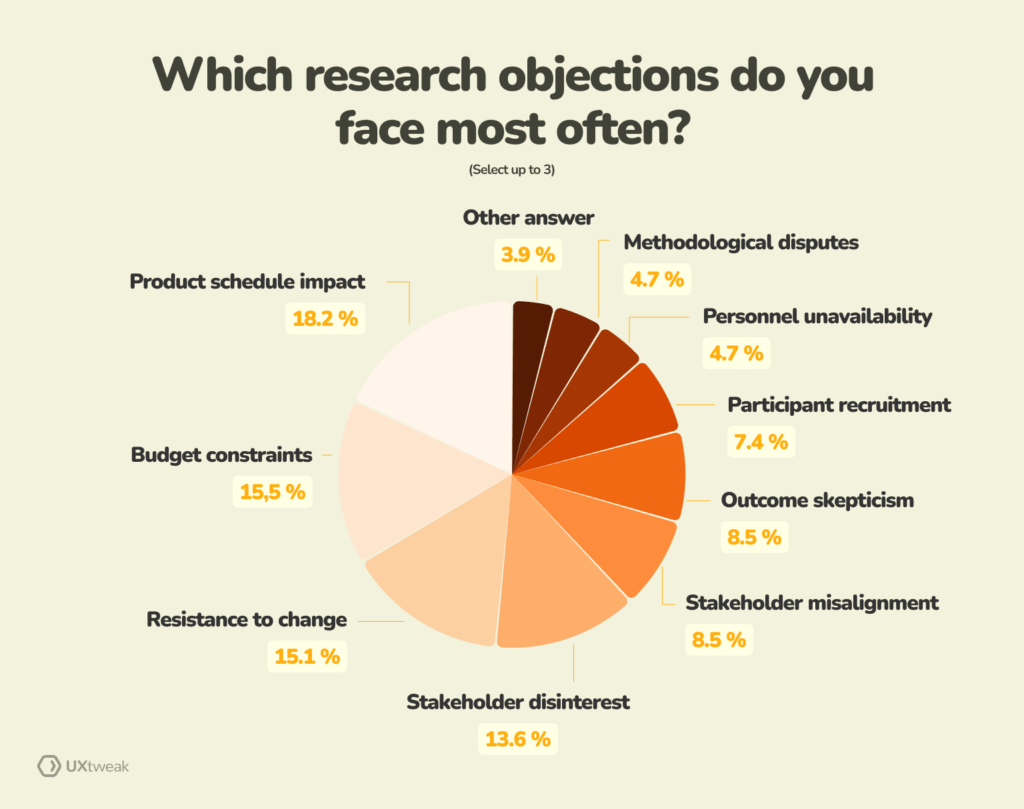
Respondents also noted objections about the value and necessity of user research.
Some stakeholders believe usability isn’t the issue—users just need to learn the system. Others think only highly involved stakeholders have valid opinions, ignoring broader research.
Some resist changing established workflows or feel they already know user needs, relying on marketing insights instead of UX research.
🔥 Jump to the list of Practical tips from UX professionals for overcoming stakeholders’ objections to research and securing their buy-in.
👉 In our deeper analysis, we segmented the results based on responses to several demographic questions.
This allowed us to understand how the objections faced by UX professionals correlate with their:
-
- Years of experience in the UX industry
-
- Type of organization
-
- Size of organization
Objections faced by years of experience in the UX industry
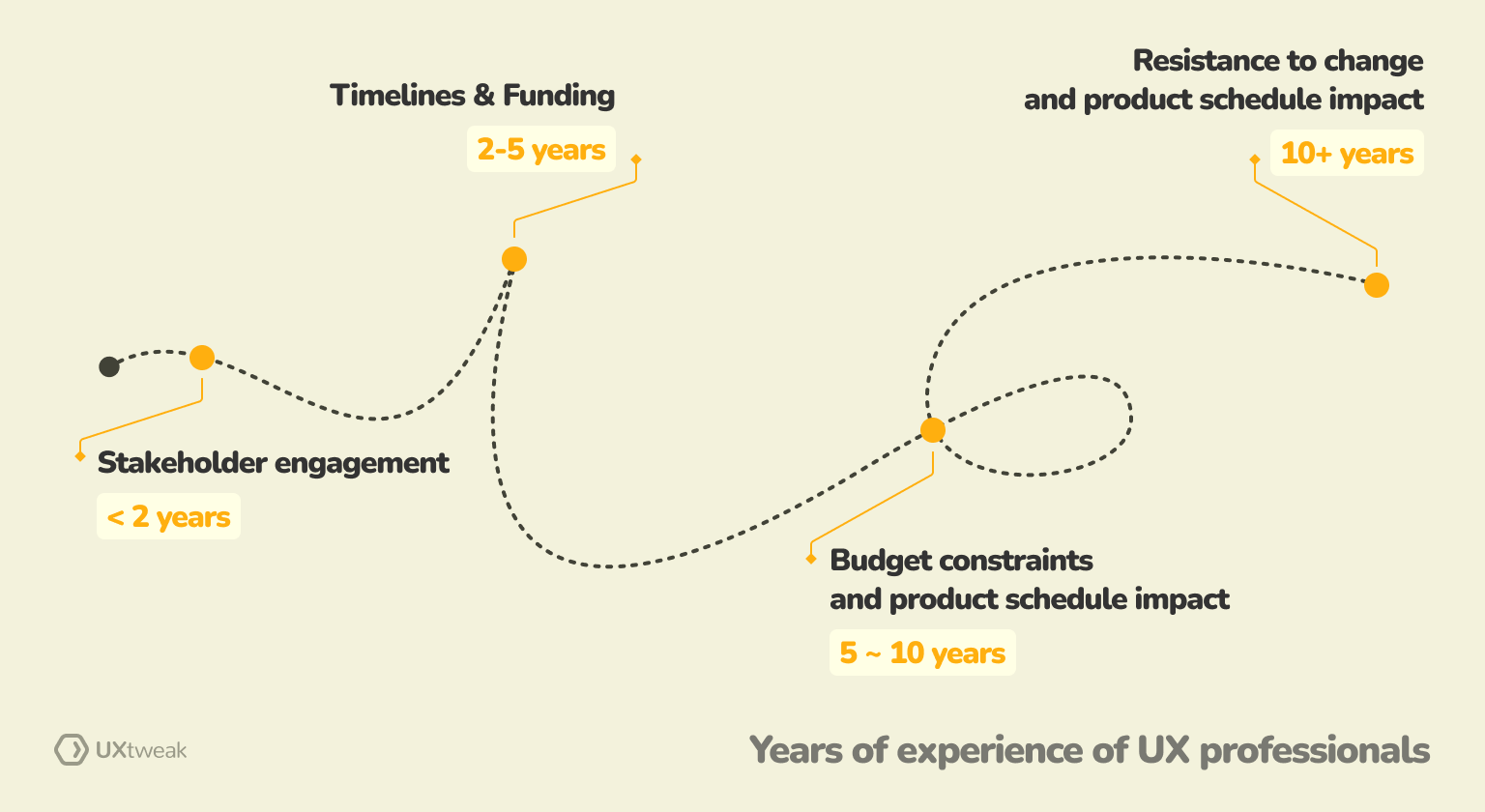
Overall, securing stakeholder buy-in and managing product schedule impacts remain critical challenges at all experience levels.
Resistance to change becomes increasingly prominent for more experienced UX professionals, evolving from a secondary challenge for early-career professionals to a primary obstacle for seasoned experts.
Early-career professionals (less than 2 years) struggle most with stakeholder engagement (66.67%).
Those with 2-5 years experience face challenges with timelines (76.67%) and funding (56.67%).
After 5 years, budget constraints (63.16%) and schedule impacts (57.89%) remain, but resistance to change grows (57.89%).
For UX veterans (10+ years), resistance to change (68.75%) and schedule issues (62.50%) persist, with rising stakeholder disinterest (62.50%).
Objections faced by type of organization
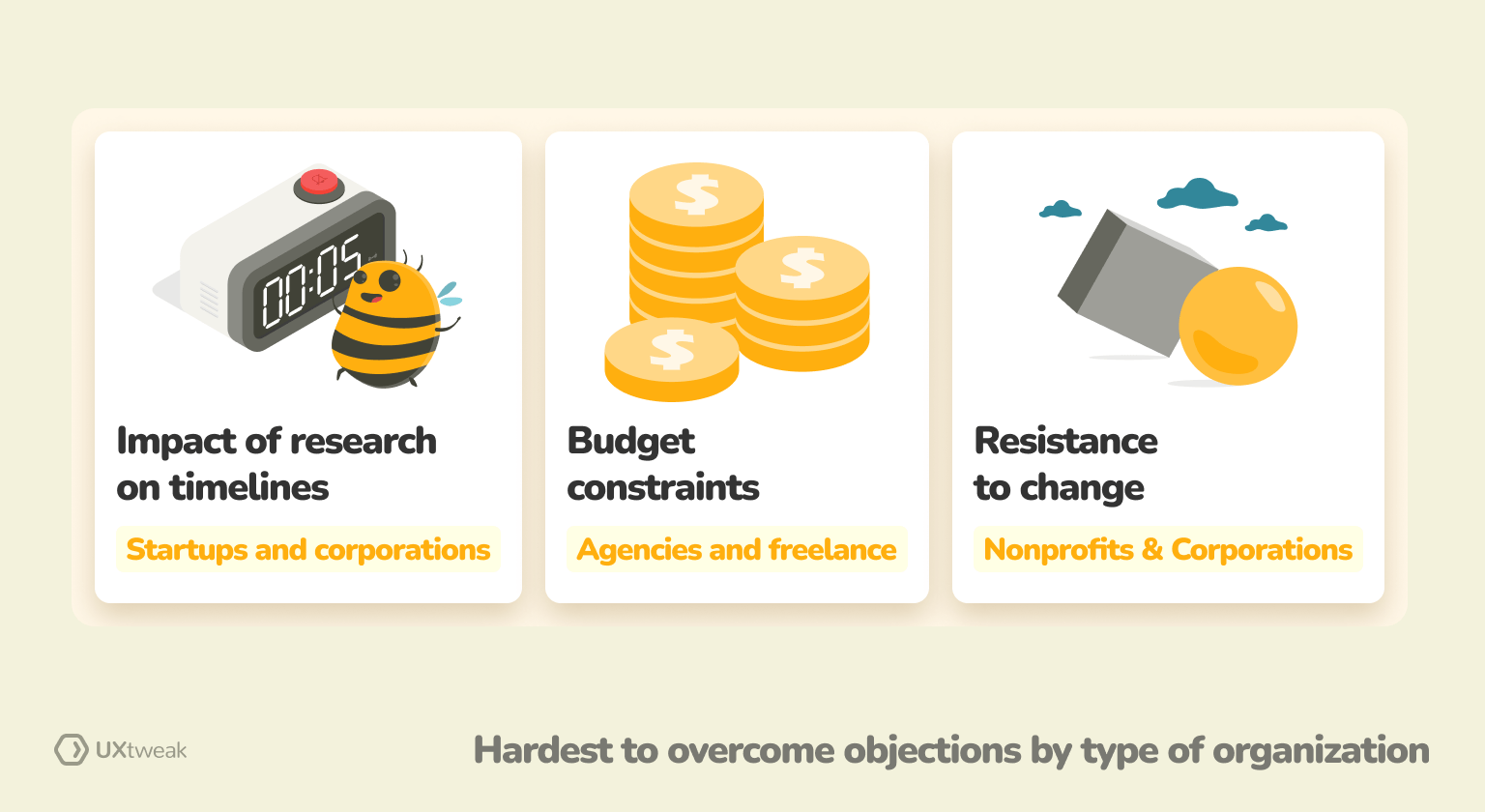
Overall, securing stakeholder buy-in and managing product schedule impact remain critical challenges at all organization types.
Startups and corporations frequently struggle with the impact of research on timelines.
However, budget constraints are particularly pressing in agencies and freelance settings, while resistance to change is most significant in nonprofits and corporations, highlighting the difficulty in altering stakeholder opinions in these types of organizations.
Objections faced based on the size of organization
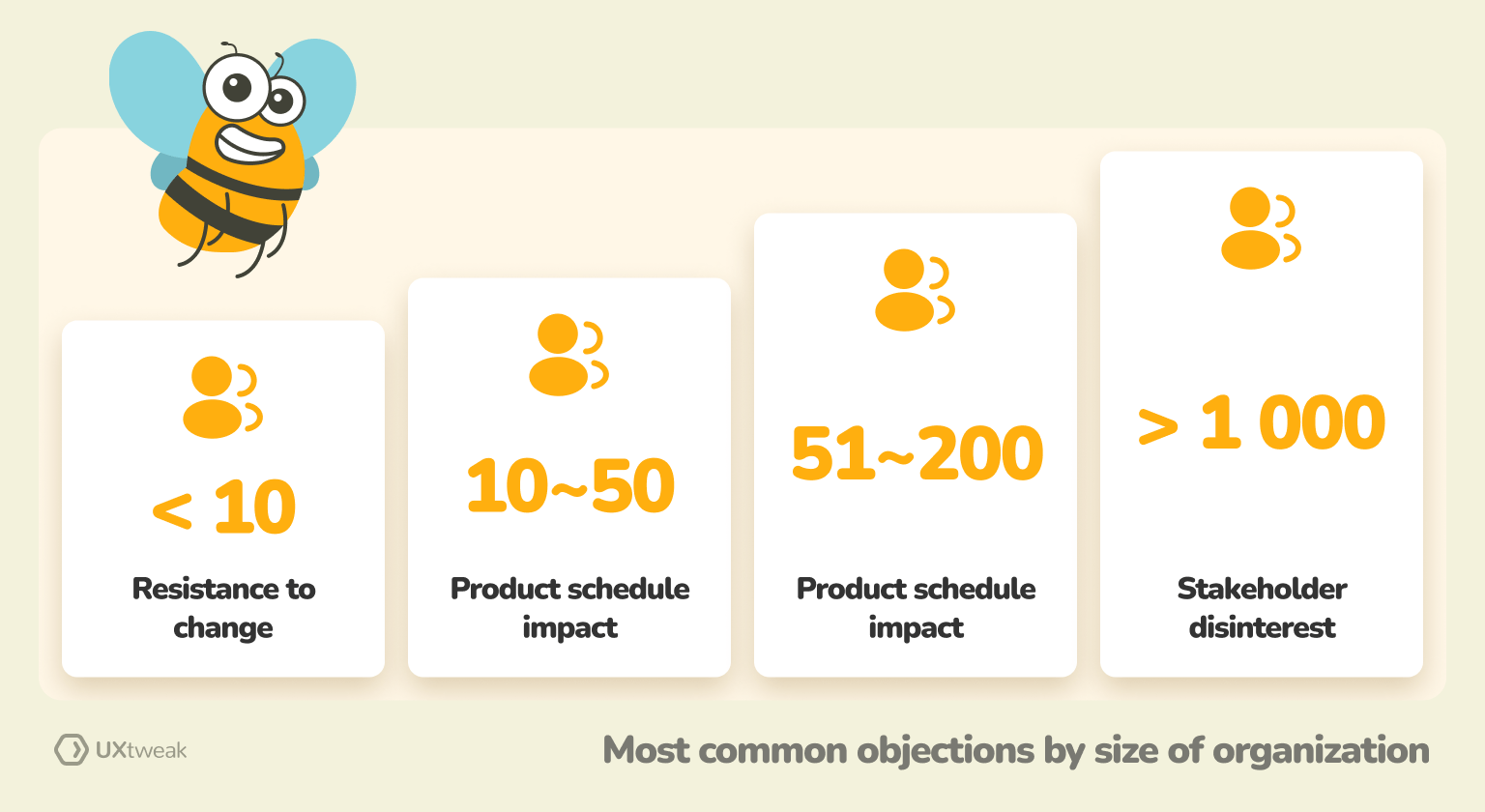
Across various organization sizes, types, and experience levels, product schedule impact and budget constraints consistently emerge as primary challenges.
Resistance to change increases with both company size and the years of experience of UX professionals.
In smaller organizations (under 10 employees), resistance to change (80%) and budget constraints (60%) dominate due to limited resources. As companies grow (10 to 50 employees), product schedule impact (68.42%) becomes the main issue, reflecting tighter timelines.
Mid-sized organizations (51 to 200 employees) still face schedule impact (83.33%) and budget constraints (58.33%), but stakeholder misalignment (41.67%) emerges.
In large corporations (1000+ employees), stakeholder disinterest (68.75%), along with schedule (62.50%) and budget challenges (56.25%), are the primary obstacles, signaling the difficulty of managing engagement and resources effectively.
Analyzing the conclusions above, we’ve found an interesting pattern. Looks like resistance to change increases with both company size and the years of experience of UX professionals.
Larger organizations and more experienced professionals often face greater challenges in changing established processes and mindsets due to bureaucratic structures and strong opinions from higher-level stakeholders.
This resistance is often tied to a high investment in existing systems and a fear of the risks associated with change. Additionally, seasoned professionals tend to work in these environments because they can handle the complexity and scale of such challenges.
💡Main Insight on Most Common Objections
- Early-career UX professionals often struggle with stakeholder engagement, while those with more experience face timeline pressures, funding issues, and increasing resistance to change.
- Startups and corporations frequently encounter timeline impacts, whereas agencies and freelancers are more constrained by budgets.
- In larger organizations, stakeholder disinterest and entrenched processes become major hurdles.
- As organizations grow and professionals gain experience, the challenges in shifting established mindsets and processes intensify.
Reasons for research objections
Our respondents perceive the main reasons for objections to UX research as a lack of understanding (18.3%) and time pressure (17.9%). Organizational culture (14.8%) and budget focus (12.8%) were also notable factors.
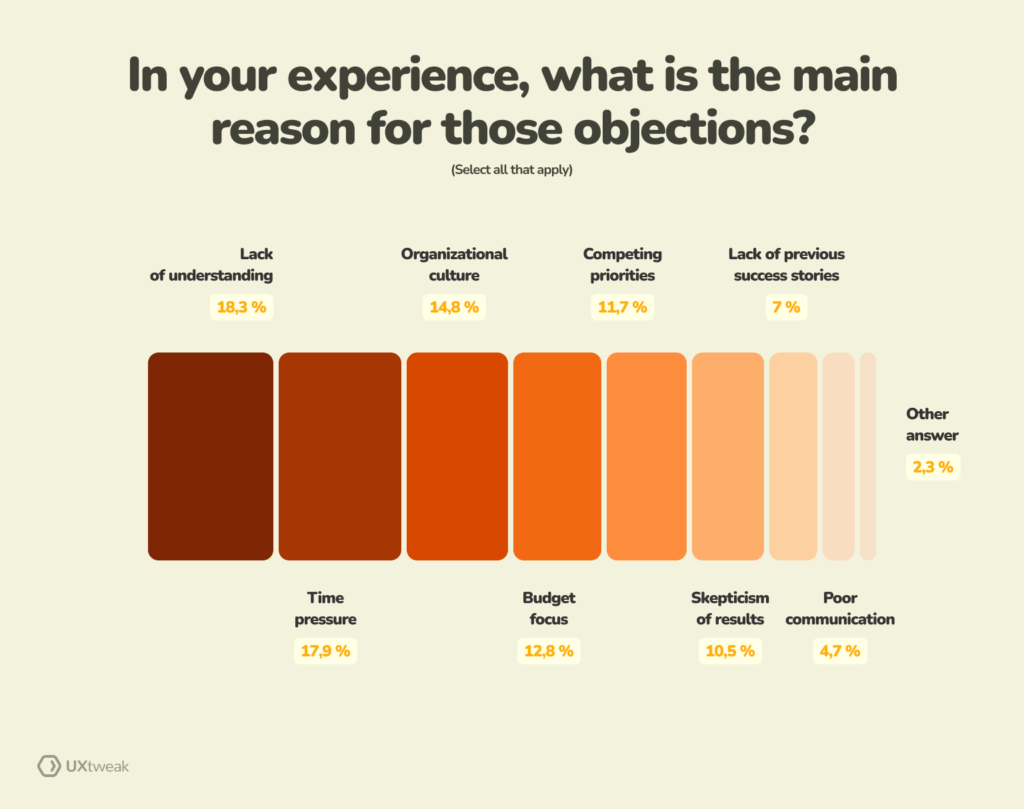
Hardest to overcome objections to UX research
The hardest objection to overcome is resistance to change, mentioned by 26.1% of respondents. Budget constraints (21.7%) and product schedule impact (18.8%) also present notable challenges.
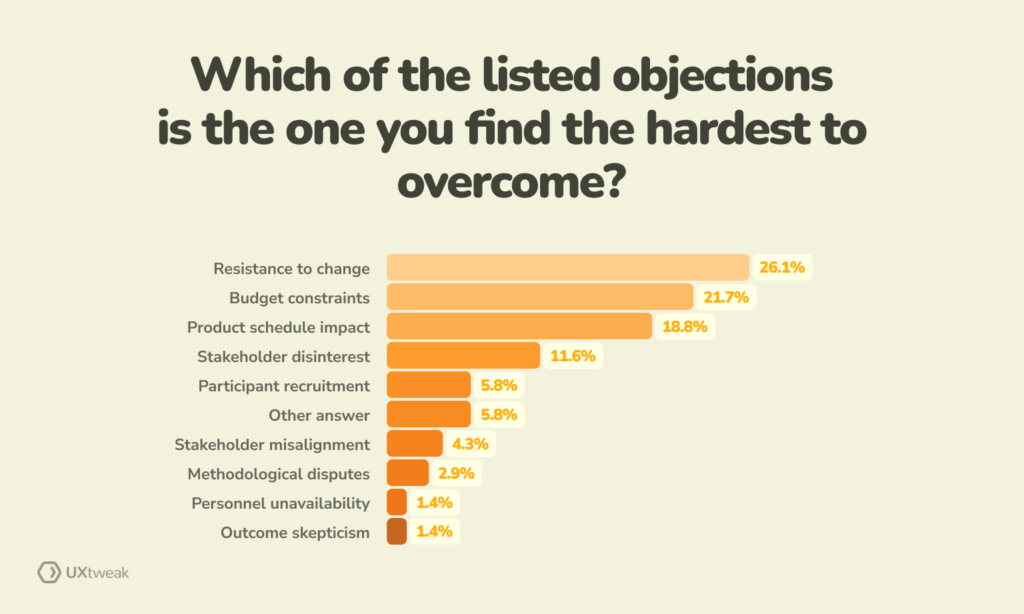
Now let’s break it down into more specific data. We’ve analyzed how hardest to overcome objections differ, depending on the type of organization, its size and years of experience of UX professionals ⬇️
Hardest to overcome objections by years of experience
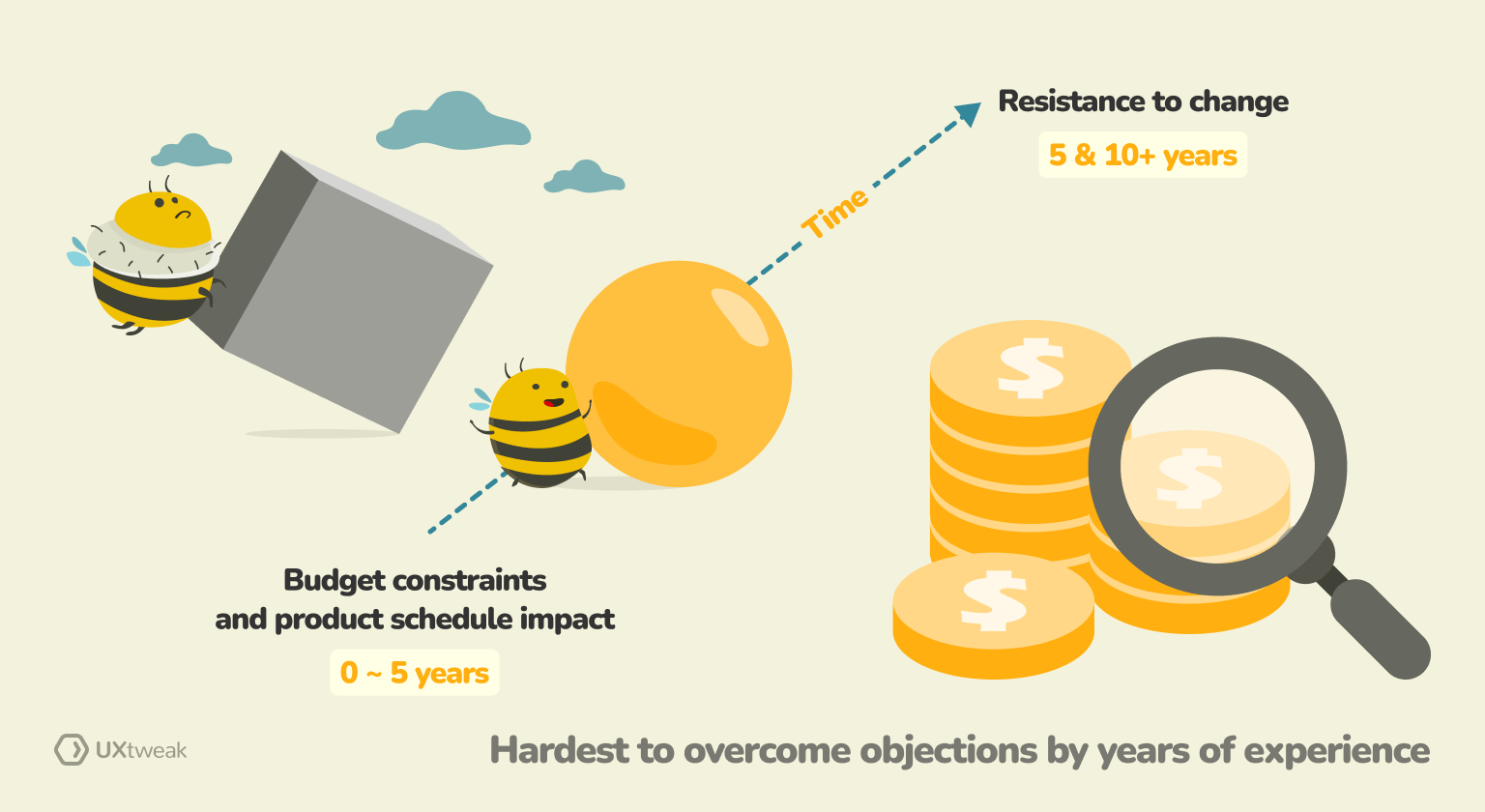
Budget constraints and resistance to change are persistent challenges across different experience levels. At the same time, the impact of research on product schedules becomes less of a primary issue for more experienced professionals.
As UX professionals gain more experience, resistance to change not only becomes a more common issue but also increasingly harder to overcome.
This trend underscores the growing challenge of altering established processes and mindsets among more senior stakeholders, emphasizing the importance of strategic communication and strong stakeholder management skills.
Early-career professionals (less than 2 years) face equal challenges with budget constraints and schedule impacts (33.33%).
Mid-level professionals (2-5 years) continue to struggle with budget constraints (23.33%) and encounter more resistance to change (23.33%).
For senior professionals (5-10 years) and veterans (10+ years), resistance to change becomes the main issue (26.32% and 31.25%), reflecting greater difficulty in influencing established stakeholders and altering processes with increased experience.
Further in this article, we share the strategies to help you effectively address that specific issue.
Hardest to overcome objections by type of organization
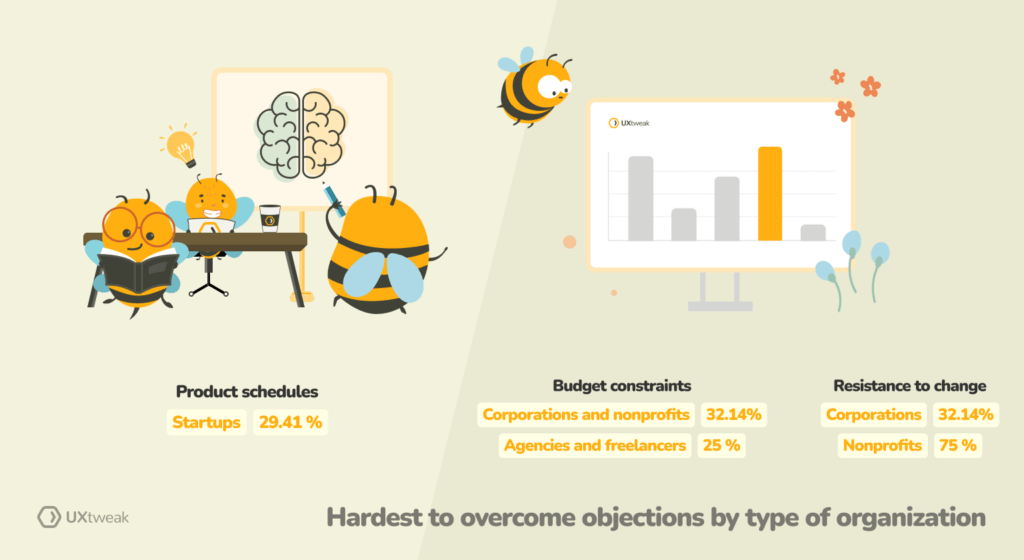
In startups, the main challenge is aligning research with rapid development cycles, while corporations and nonprofits struggle with resistance to change. Agencies and freelancers, on the other hand, face budget constraints impacting their ability to conduct research.
In startups, the primary challenge turned out to be the impact of research on product schedules (29.41%), reflecting the pressure to maintain rapid development cycles.
Corporations and nonprofits both struggle most with stakeholders’ resistance to change (32.14% and 75.00% respectively).
Agencies and freelancers face substantial budget constraints (54.55% and 25.00% respectively), underscoring the financial limitations often inherent in these environments.
These insights suggest that addressing objections requires tailored strategies: advocating for the integration of research into agile processes in startups, fostering change management in corporations and non-profits, and securing sufficient funding in agencies and freelance settings.
However, a common thread across these cases is the challenge of limited budgets. It’s important to highlight that even with the best efforts in persuasion and strategy, the lack of financial resources can be a impossible-to-overcome barrier, making it difficult to implement desired changes.
For such cases, however, there are still alternative ways of how you can implement research into the process. You’ll find advice from UX professionals on how to do that further in the article ⬇️
Hardest to overcome objections by the size of organization
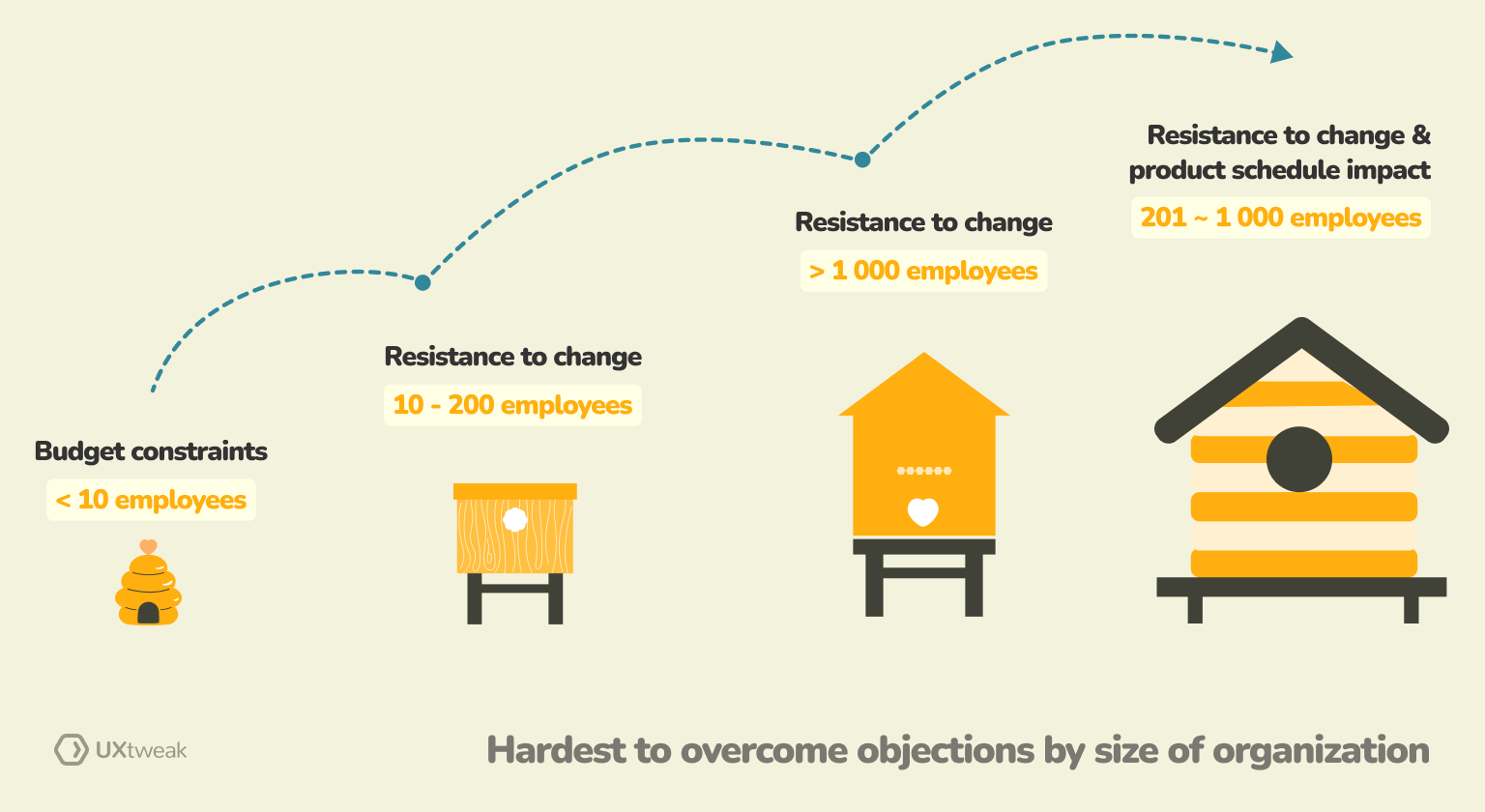
As organizations grow, internal resistance to change becomes a more significant issue.
The analysis shows that budget constraints is the hardest-to-overcome objection in the smallest organizations.
In organizations with 10 to 200 employees, resistance to change becomes increasingly challenging, peaking at 36.36% for mid-sized companies (201 to 1000 employees).
Larger organizations (more than 1000 employees) continue to struggle with resistance to change (25%), along with product schedule impacts (25%) and stakeholder disinterest (18.75%).
💡Main Insight on Hardest-to-Overcome Objections
- Budget constraints remain a consistent barrier across all types of organizations, particularly smaller ones.
- For startups, the primary issue is balancing research with rapid development schedules.
- In corporations and nonprofits, the main challenge is overcoming resistance to change, while agencies and freelancers are most constrained by budgets.
- As UX professionals gain more experience, they face increased resistance to change, highlighting the difficulty in influencing established stakeholders and altering entrenched processes.
🔥 Advice from UX experts: How to deal with stakeholders’ objections to research?
For each of the objections voted to be the hardest to overcome we asked our respondents to share how they dealt with this specific objection and what strategies have previously worked for them.
Below, you’ll find a summary of the main strategies to combat each of the following objections:
- Resistance to change
- Budget constraints
- Product schedule impact
- Stakeholder disinterest
- Participant recruitment
- Stakeholder misalignment
- Methodological disputes
💡Summary of Key Strategies
So, before diving into each specific objection and tips to address it, here’s our summary of the 9 key strategies for addressing stakeholders’ concerns, which you’ll find below ⬇️
- Get stakeholders to participate in the interviews and usability tests to see user struggles firsthand
- Use case studies to illustrate the value of research and how it prevents costly mistakes
- Provide detailed cost-benefit analyses to show the financial impact of conducting research versus the risks of not doing so
- Start with small, incremental studies to demonstrate value and gradually build stakeholder confidence
- Address stakeholder concerns by engaging in open discussions and finding a middle path that acknowledges both sets of data
- Show the impact of research on competitors’ examples
- Break silos within the organization by fostering communication and educating about the value of research
- Employ guerilla research methods for quick, budget-friendly insights
- Prioritize relationship-building with stakeholders and demonstrate quick, impactful wins to build trust
You can find a summary of those strategies with practical examples on how to apply them in our FREE downloadable UXR Cheat Sheet 🐝 : 8 Strategies for Dealing with Research Resistance
Don’t have time to read it all?
Watch this short video summary 🎥 or download our UXR Resistance Cheat-Sheet with 8 practical strategies for your next battle with stakeholders:
Now, let’s dive deeper into each specific objection.
1. Resistance to change
26,1% of respondents voted for this as a research objection that is the hardest to overcome and deal with.
This quote from our survey, from a UX or Product Designer with 2-5 years of experience, perfectly describes the frustration associated with the hurdle of trying to battle stakeholders’ resistance to change:
After months of false promises and many pointless debates, the most effective seems to be simply leaving the company.
When stakeholders ignore research and resist change, it can feel frustrating and unmovable. This resistance, whether passive or active, makes implementing findings or conducting research difficult, sometimes leaving walking away as the only option.
However, the UX professionals from our survey shared a bunch of actionable advice from their experience that helped them combat the issue successfully.
Involving stakeholders 👥
One effective way to combat this resistance is by directly involving stakeholders in the research process.
As Respondent 393 highlights, having stakeholders observe usability testing can shift their perspective.
The greatest impact and best way to turn resistance into acceptance has been for them to attend usability test sessions and watch the users struggle.
The first time they may see a user struggle they will blame the user but hopefully by the second or third they begin to accept that the user is not to blame but the design fails to meet the users’ mental model, needs, and/or expectations.
And there is a bunch of evidence that this method actually tends to work.
In our conversation with Lead User Researcher and Social Psychologist, Konstantin Esher, in UXR Geeks episode on breaking down communication barriers, he explains how this approach worked wonders in his own practice:
When I was the only and first researcher, I shared my interviews as they happened live with the entire company. So everyone got a link. Everyone could just tune in and watch. And there was not much I had to do to sell user research because people started having conversations.
All of a sudden the CFO joined to watch, started watching these interviews and they started discussing with some other department heads.
There’s not much I have to do here to sell research. They get it already. They already memorize certain quotes from users. They already try to understand why certain people struggle here or there during usage, right?
Konstantin explains that there are multiple ways to do this.
What you can do is create highlight reels, snippets, quotes, make stuff more visual. Make the users speak in their own names. Don’t be the one who’s pushing. Let the user speak for themselves. And that is absolutely possible also with GDPR.
💡 Pro Tip
With dedicated tools like UXtweak’s Live Interviews, it super easy to invite stakeholders to your sessions!
You can add them as Observers and send them a link to join.
And in case they won’t make it – create reels and extract highlights of your interview sessions to present to them later!
With UXtweak you can do so in one click🔥
➡️ Learn more about UXtweak Live Interviews
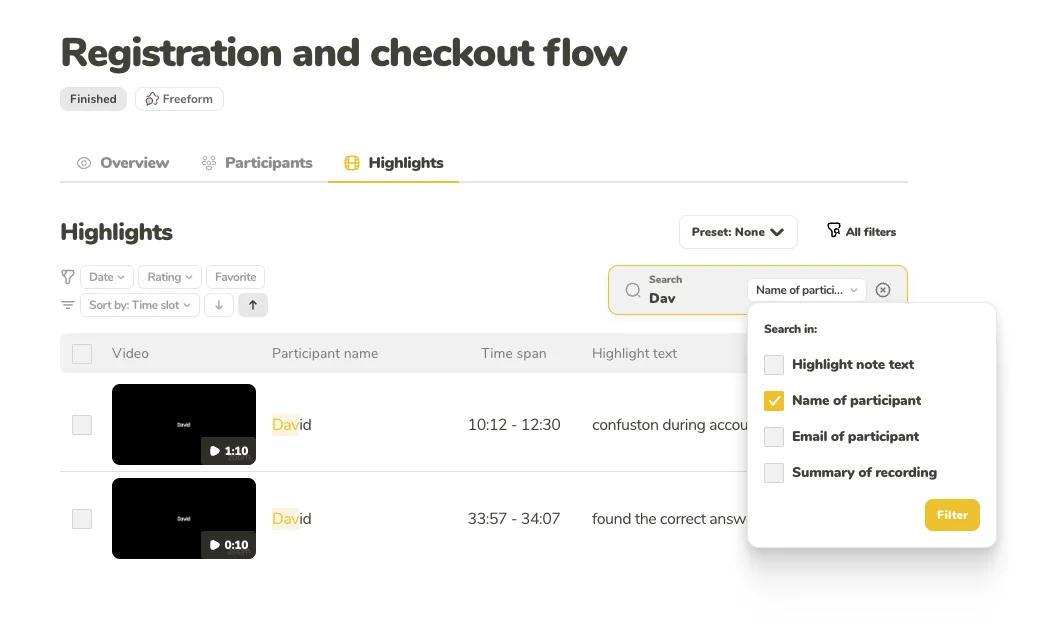
Another respondent highlights a critical challenge when UX research data clashes with other data sources like market research, convincing stakeholders can be particularly tough.
In such cases, if stakeholders are at least somewhat open to the results, the key is to engage in open discussions.
It depends on the context. If a stakeholder believes UXR data doesn’t align with other data (eg market research) there’s nothing effective at convincing them.
If they’re open to the results at all then it’s just about talking through their hesitations to find a middle path forward.
By clearly outlining how the proposed changes can lead to positive outcomes and what the potential drawbacks of inaction are, you can help stakeholders see the value in embracing the change:
Explaining in more detail the benefits of the change and the potential risks associated with not making the change.
Further down the article, we’ll share additional tips on how to make your discussions with stakeholders more effective by providing relevant evidence to prove your points.
Case studies and ROI 💸
“Talking in numbers” (CFOs will appreciate it) can be far more persuasive for certain stakeholders, rather than qualitative insights.
Case studies reveal how assumptions can be wrong and highlight the true needs of users. Use examples from past clients, competitors, or any relevant case to make your point.
Pointing out case studies where a design has failed due to false assumptions about user needs – promising to validate existing knowledge through more open exploration.
or
Showing them examples of previous clients who thought they knew their customers but user research proved otherwise…
Another way to approach this is by presenting a detailed cost-benefit analysis that quantitatively illustrates the financial implications of conducting research versus the risks of not doing so.
This will help you appeal to stakeholders’ financial sensibilities by showing how research can prevent costly mistakes and ensure resources are used effectively:
Showing a cost-benefit analysis of doing UX research (cost of building the wrong thing)
Success stories from the past can also help to support your claims about the value of research.
Another respondent recommends this method as a way to show the value and effectiveness of your work.
Showing previous examples of research and the goals, results we achieved.
Starting slow and scaling gradually 📈
One strategic approach to overcoming stakeholders’ resistance to change is to start with small, incremental studies and gradually demonstrate the value of research over time.
This strategy aims to show how even small research efforts can lead to improved project outcomes and cost savings. However, it’s important to keep in mind that this method is not suitable for every case due to its slow pace and the prevailing “move fast and break things” mentality in some organizations.
Very very slow, gradual, careful engagement where you can get across that you are working WITH stakeholders not FOR them. It takes SO long!
Download the Cheat Sheet 📥
8 actionable strategies from UX professionals to overcome stakeholder’s objections to research & secure buy-in
Get your free copy now ⬇️
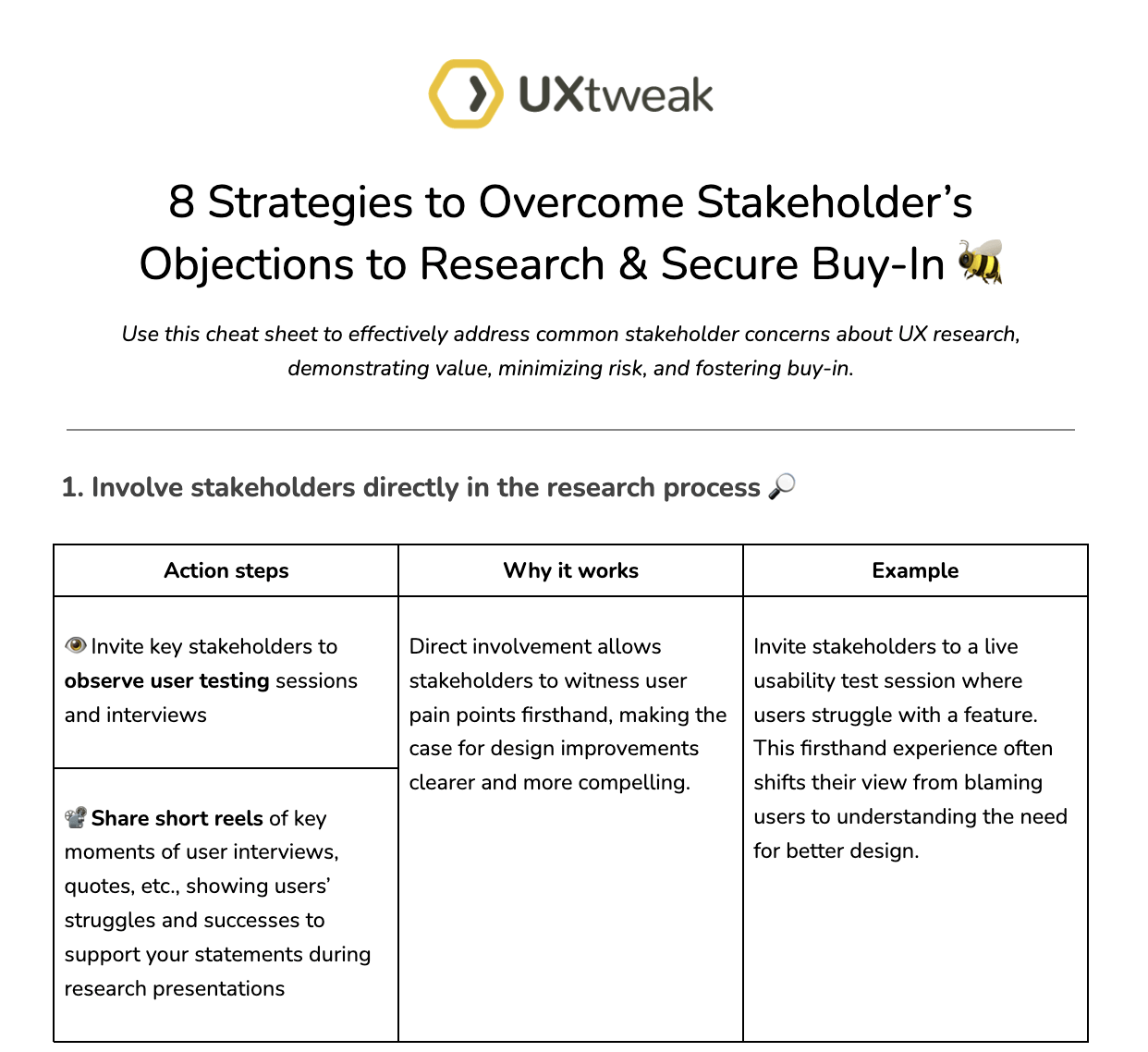
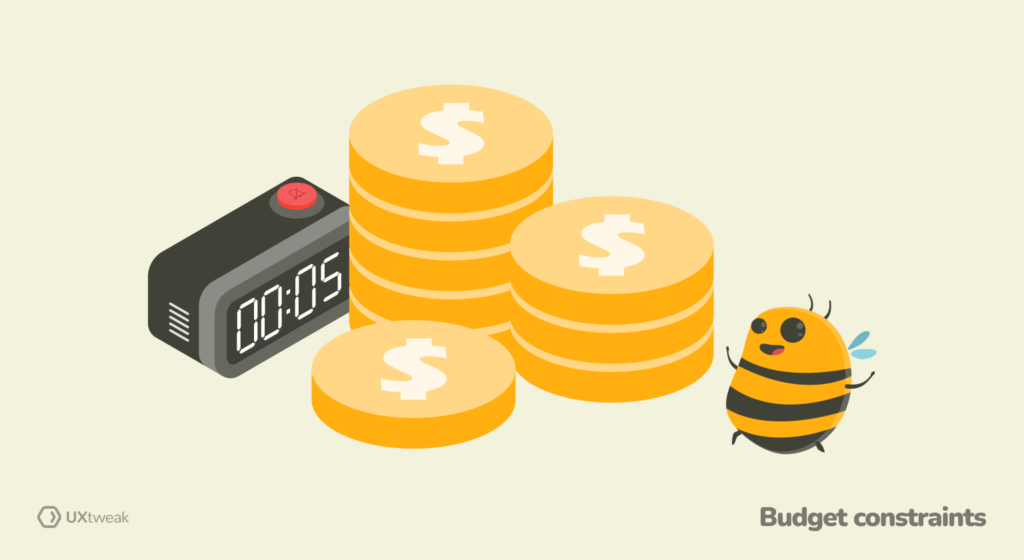
2. Budget constraints
It’s no secret that stakeholders often prefer to complete the project faster rather than invest the needed time and resources in research.
This happens so often that 21.7% of our respondents voted for “Budget constraints” as the second hardest objection to overcome.
It’s about competing priorities and no will to spend a lot of time on research. The priority is to get the job done fast, disregarding the value of research.
Stakeholders often prioritize fast, seemingly cheaper solutions over research. The challenge is reframing research as an investment, not an expense, that leads to more effective, user-focused results.
Let’s take a look at some strategies that can help to achieve this.
Alternative methods 🌱
When securing a research budget isn’t possible, even after advocating for it, using less resource-intensive research methods can still get you valuable insights.
Finding alternative ways to implement gathering data and feedback and letting design and product teams try to do a little research.
So design/dev can look at analytics, call center data, implementing behavior tracking tools, sending out surveys.
For example, guerrilla research methods, such as quick intercept interviews or informal user testing, can be highly effective for gathering initial insights and validating hypotheses with minimal investment:
Propose guerilla methods permitting to get some inputs without spending too much time/money.
We also developed t-shirt sizing offer for user research to help clients to understand what they need regarding their project importance.
Start small 💫
Starting with small research projects can help build stakeholder trust. If they’re hesitant to fund larger efforts, show the value through quick wins and small-scale results.
Over time, this can encourage more investment in bigger research initiatives.
Talk to clients directly and explain what I plan to do and what value it has. Don’t rely on my own consulting and sales colleagues.
Start with small-budget things and then get bigger.
Business case and ROI 💰
Stakeholders often respond best to concrete examples of how research impacts business results.
Using data and numbers can help secure buy-in, especially when facing budget constraints. Present case studies showing how research has improved performance—such as increased revenue or cost savings—so stakeholders can clearly see the value of your findings in real-world terms.
Showcasing past wins – tying the research to business outcomes and revenue generated/saved.
Trying to make a business case with how much potential cost reduction or gains we can get.
Talking in numbers to back up qualitative arguments, like keeping customers for longer if we make sure to meet their needs from the start.
For example, you can show how in a previous project user research led to a 20% increase in customer satisfaction and a 15% boost in sales.
Quantifying the financial benefits of research initiatives and comparing them to the costs has proved to work for multiple respondents as well.
Trying to make a business case with how much potential cost reduction or gains we can get.
Talking in numbers to back up qualitative arguments, like keeping customers for longer if we make sure to meet their needs from the start.
For example, if a research project cost $50,000 but led to product improvements that generated an additional $200,000 in revenue, the ROI calculation would highlight a 300% return on investment. Such numbers can be very persuasive to stakeholders focused on the bottom line.
Clearly communicating how research speeds up problem identification and resolution can help teams argue that it accelerates project timelines.
For example, proving that user testing can quickly reveal critical usability issues that, if left unchecked, could cause delays later in the development process.
Explaining how research will help speed up the solution timeline
In one of the discussions on Reddit a user explains it with a great example:
I think a lot of it is misunderstanding the benefits combined with UX people who don’t speak in practical measurable fiscal benefits to the company.
Saying ‘this is a poor workflow’ is a lot different than ‘this will make every time CS processes a return cost you nearly 2x as much in labor time’ or ‘If we put the filter here, finding a customer will take 20% less time, which means shorter call times and better handling’.
And so on. But in terms of how customers will get better outcomes that help the company. Too much is framed in terms of ‘the right way to do this’ or ‘users prefer’, etc. And so UX/UI people in the room often sound less grounded than they really are. The costs of their work aren’t grounded in the savings nearly as much as they could be.
– LitesoBrite on Reddit
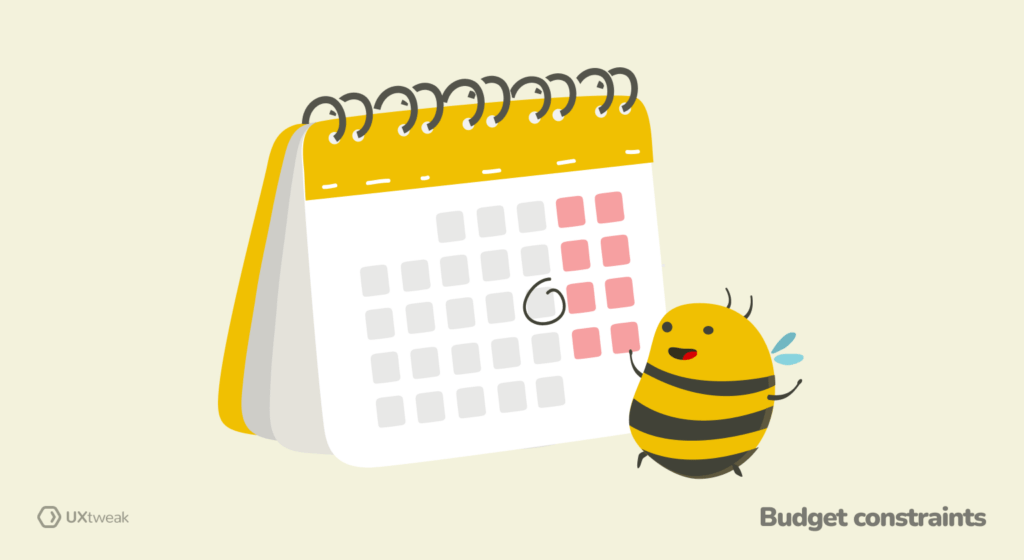
3. Product schedule impact
Stakeholders often think research will delay projects, leading them to skip it. However, there are fast research methods that fit tight timelines.
The challenge is balancing speed with quality—ensuring deadlines aren’t affected while still gathering valuable insights.
Let’s take a look at what other professionals suggest.
Early inclusion and planning 🗓️
The first and biggest tip here is to plan ahead when possible.
Jason A. Hubbart’s latest research on “Maximizing Research Impact in Higher Education” names early identification, categorization, and engagement of stakeholders throughout the research process as one of the most effective strategies for getting buy-in.
Start research early in the project timeline to ensure there’s enough time to properly explore user needs without causing delays.
This is a long term run but from my perspective you have to get to know about project in early stages and incorporate research into roadmap. So its about proactive approach of researches to get information that something going through personal connection within organisation.
So step 1 is about build those connection and step 2 is about ability to sell research to decision maker. There for me function not just success stories but also to remind some fuckups from the past.
Highlighting the risks ❗️
Another strategy here is to explain the potential risks of not conducting research. This can be a powerful motivator for stakeholders.
Explain them how research can help to prevent costly mistakes:
Explaining that we will lose more time if we make a wrong product development decision vs running a research study.
Debbie Levitt, CXO of Delta CX, describes it well in one of our podcast episodes The current state of UX/CX, start-up & business management. Research is the tool for de-risking. And that’s exactly what we need to explain to stakeholders in order to demonstrate its value.
Research is for de-risking. Research gives us knowledge where we had guesses, and it helps us know the right directions to go with our products or services without wasting time guessing.
Vitaly Friedman, UX designer, speaker, and co-founder of Smashing Magazine, further supports this point in one of his latest talks:
When I speak about design, when I speak about research, I speak about risk management.
Because to me, design and research are fantastic tools to mitigate risk, not in terms of compliance and legal obligations and stuff like that, but spending and wasting an incredible amount of resources building the wrong thing that is never going to fly.
When I bring in this notion of risk or risk mitigation into the meeting, all of a sudden the design work that we’re doing is seen a bit differently. I mean, you still need to tell a story.
In another episode of UX Research Geeks, Aurelia Alston, a Product Researcher with extensive B2C and B2B experience, shares how this approach worked in her experience.
In a story she shares the research results presentation helped to shift leaders and avoid making a risky investment that would potentially make a wrong impact on the organization.
There was a really specific hypothesis that the business had about investing.
And this is in an e-commerce and fitness space, and it was in a market that this organization didn’t have much experience in.
It was in an international market that the organization had a lot of business experience in, but not a lot of experience deeply understanding the kind of typical consumer that they were looking to make a relationship with.
And we learned that essentially one of the biggest investments or strategies would actually degrade some of the trust that organization or that brand would make with the end user, because it was a space that they felt was a very different culture, they shouldn’t be speaking to.
So in that case, the research, actually the presentation of the research and the data we had gathered the evidence for, actually shifted the leaders to move away completely from that strategy of getting people, giving people advice on a topic that they felt that organization shouldn’t be giving them, and instead they invested elsewhere.
I’ve seen that very regularly in research.
Organizations with different levels of UX maturity handle research objections differently.
One of our respondents shares that their company likes to create an MVP and then iterate based on feedback and new insights:
Our organization likes to create an MVP (minimum viable product) and then pivot as we go. They don’t have an issue with some level of research.
If it’s a huge project that would be a massive change, then we will have some research. I feel that my company and a lot of companies more ride on best practices and things that have been found historically as opposed to pinpointing the research directly on their market.
Others prefer to take a flexible and reactive approach, not planning the research ahead, but rather introducing it as a solution to stakeholders’ concerns throughout the development process:
For UT, we would only float it as an add-on midway through a project, as by then, they’d have doubts/questions they’d like to test.
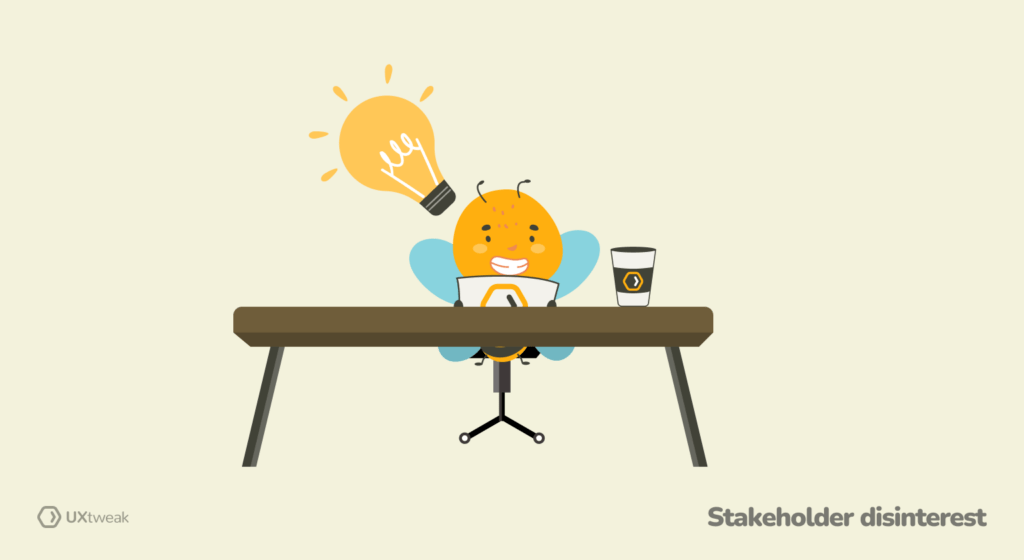
4. Stakeholder disinterest
Stakeholder disinterest often stems from a lack of understanding about the value of UX research. They may not oppose research directly but prioritize short-term goals, deadlines, and budgets.
11.6% of respondents find this objection hard to overcome. But there are still ways to educate stakeholders and build trust, showing the importance of user insights.
Building trust and demonstrating value ⚡️
To persuade stakeholders, focus on providing clear, tangible proof of how your ideas will help. Instead of just explaining research benefits, show them quick, impactful results that directly benefit the project.
Respondent 86 emphasizes that building relationships is also crucial:
Explaining why UXR will benefit them; building relationships so they trust me/my team; prioritizing quick “wins” that SHOW (vs tell) why UXR is good/helpful for their work.
Examples of quick wins could include simplifying a complicated workflow based on user feedback, or conducting a brief usability test that identifies and resolves a critical usability issue.
Explaining why UXR will benefit them; building relationships so they trust me/my team; prioritizing quick “wins” that SHOW (vs tell) why UXR is good/helpful for their work.
Involving stakeholders in planning 🤝
To combat stakeholder disinterest, start with small, budget-friendly research studies. These provide initial insights you can use to demonstrate the value of full-scale research.
This approach is low-risk since it requires minimal investment, making it easier to win stakeholder support without demanding significant time or money upfront.
Guerrilla tactics: doing small/budget-friendly research, explaining results & impact. Involve stakeholders into planning and explain research importance.
Impact of poor research 👀
If showing the benefits of research doesn’t work, highlight the risks of skipping it. Point to product failures caused by poor or absent research.
Use case studies, personal examples, or well-known failures to show the consequences of neglecting user insights. This can make the importance of research more clear.
Showing some good examples of spectacular project failures due to a lack of knowing users’ context sometimes does the job.
Showing examples of hilarious failures when somebody did not do research.
According to our respondents, highlighting the numbers here is also a powerful strategy.
Don’t stop on just showing the failures of other companies, show how much they lost on these failures, and calculate how much you can lose too:
Showing the risks involved in not having the research, the expense of going down a development or marketing path that is a guess, and showing a better path to the goals they have stated they want to achieve.
Showing examples of competitors success 🏅
Lastly, show how your competitors benefit from research can also provide a strong incentive for stakeholders to invest in their own UXR efforts. Explain why you’re losing the competitive advantage by overlooking research.
For some stakeholders, this can be particularly motivating, as it appeals to the desire to stay ahead in the market.
Showing research articles and current ROI on research within the same industry for competitors.
As Konstantin Esher beautifully puts in the UXR Geeks podcast (breaking down communication barriers), it’s important to understand the business too. Do not get caught up in silos but promote communication, educate others about the value of research, and integrate it proactively in your processes.
nana 1
We as researchers, we need to care about the business as a whole.
We shouldn’t play along the siloed structure and just care about what we believe is important to us, but rather understand the company as a whole, and then walk from door to door and try to break these silos by connecting people, by creating a common understanding of what we’re all doing here.
nana 2
papapapa
nana 3

5. Participant recruitment
Recruiting participants for UX research can be difficult, especially for niche audiences. Stakeholders often see it as time-consuming and expensive.
However, with the right approach, even niche participants can be found. Simplifying the recruitment process and addressing concerns about cost and time can help to ease stakeholder worries.
Need help with niche recruiting? 🐝
UXtweak User Panel is here for you!
Not only we’ll give you access to panelists from more than 130 countries, but also will make sure you get just the right people for your study – no matter how niche!
Let our panel experts recruit the hard-to-reach respondents for your study ⬇️
Here’s how other researchers are dealing with this problem.
Building a participant pool 🏊♀️
Seems like one of the most popular and effective ways to recruit in an environment where stakeholders are skeptical about the value of research, is to recruit from your own pool of participants.
However, a pool like this can be created only when you already had some previous studies and recruited people for them.
Trying to create a “Testing Pool” of participants.
Having a “go-to” participant pool who has been responsive in the past.
To make the process of building your own pool easier, a Product Discovery expert, Caitlin Sullivan suggests leveraging referrals:
Ask every participant you find who is a really good fit if they know someone who might be up for joining your research. It can make recruiting the right kind of people much faster!
For building and managing your own participant pool, a handy tool is a must! UXtweak Own Database feature is a dedicated UX Research CRM that helps you do just that.
Build a Participant Pool with our Own Database feature 🐝
Use Own Database by UXtweak to easily manage your participants and invite them into ANY UXtweak study.
With our participant management tool, you can have your research participant database ready for recruiting in just a few minutes.
➡️ Learn more about Own Database
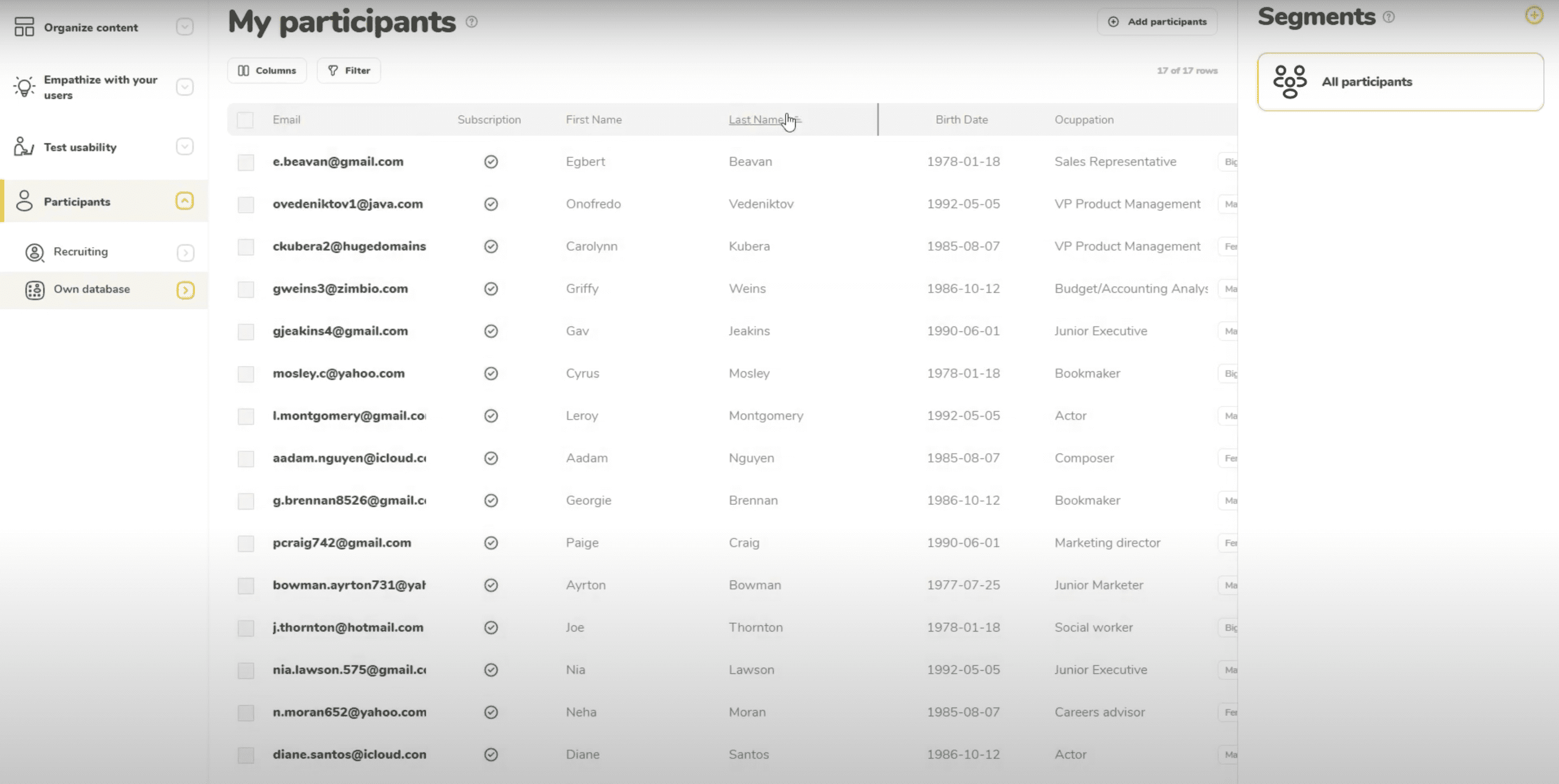
One more great strategy is to engage your customer success team in the process of finding testing participants:
To address the “Participant recruitment” objection, we have found it effective to engage our customer success team to ask clients if they are willing to help improve the product through usability tests or interviews.
Many clients are already willing to assist, and we can further increase participation by offering incentives such as gift cards, which provide a tangible reward for their time and feedback.
There are many ways you can recruit the right people for your studies and how you can optimize your recruiting strategy.
At UXtweak, we recently surveyed the UX community to gather expert recruiting tips and understand how experts approach the process of recruiting effectively.
➡️ You can find all of the tips we’ve collected in this article: UX Research Recruiting Tips from 19 UX Experts [+ Checklist]

6. Methodological disputes
Stakeholders often disagree on research methods, with some preferring traditional approaches while others rely on basic analytics. These disputes can block UX research adoption. The solution is to be flexible and educate stakeholders about the value of different methods.
I think showing success stories SHOULD work, but I am not sure it does.
Working at a university means some stakeholders worry that methods are not “scientific enough”, which I try to counter with “this is not meant to be science”, but I am not sure it works as intended.
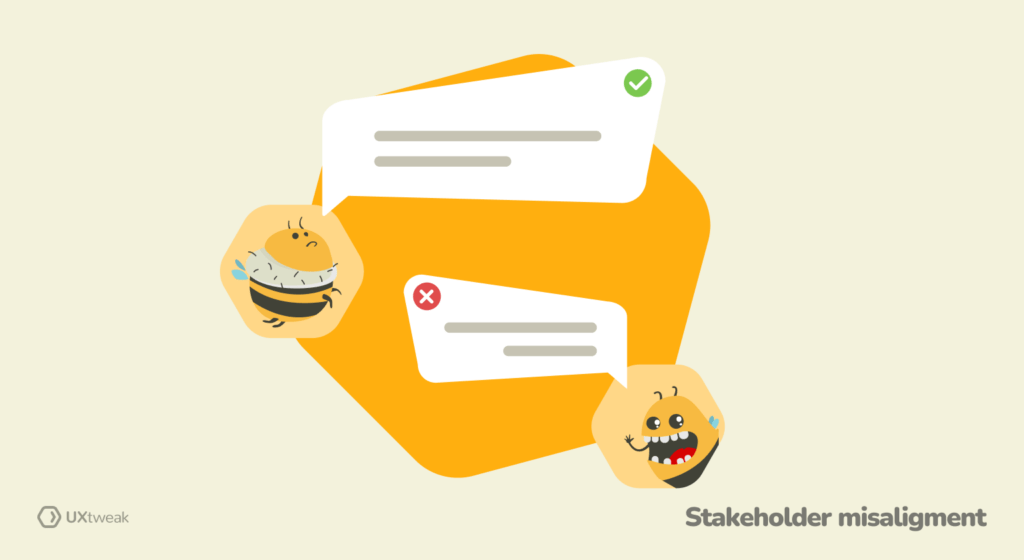
7. Stakeholder misalignment
In dynamic environments like startups, stakeholder misalignment is a common issue due to differing goals and priorities. This can create conflicts and slow down user-centered initiatives.
Respondents recommend continuous advocacy and proper documentation as key strategies to reduce misalignment and keep everyone on the same page.
Working at a startup, stakeholder misalignment is a daily occurrence. To help address this, I provide solid user feedback and strong designs that push my point further.
Another way to address misalignment is by organizing collaborative sessions where stakeholders discuss their goals and challenges. These discussions help uncover common ground and align their objectives with user needs.
Putting the stakeholders together and getting to the bottom of their actual questions that they want to solve. And see how we can combine both wishes and needs the best.
Another trick is to combat stakeholder misalignment with more research and suggesting asking users to solve their debates:
When there is disagreement among key stakeholders about a design decision, one effective strategy is to conduct a quick usability test with a few design versions.
This approach allows us to prioritize data-driven results over personal opinions, ensuring that the best design choice is made based on user feedback.
Darren Hood, a highly accomplished UX design expert, in his talk with Tina Lickova for the UXR Geeks podcast, emphasizes the importance of educating and evangelizing UX still, as research is yet to be the common practice in every project:
I know some people don’t like the concept of evangelizing UX. We still have to do it. It’s embedded in every in all the work that we do. Every project we worked on is an opportunity for education.

BONUS TIPS333
We also gathered general tips from UX professionals on how they address stakeholders’ concerns and overcome resistance to research.
Below you’ll find them categorized for your convenience ⬇️
Building relationships and collaboration 🔥
tyest 1
Fostering strong relationships and effective collaboration with stakeholders is essential for the successful implementation of UX research long-term.
Building relationships is key, I find.
These relationships help ensure that stakeholders see the value of research and are more likely to support and engage with the process.
Another trick to try is canvassing – meeting stakeholders individually and talking to them in private.
Oscar Baruffa, Analytics Manager, Blogger, Creator of BigBookofR.com, and Author or Project Management for Data Analysts, in his blog post “Dealing with difficult stakeholders” explains that in his experience it is often the only effective way to get things done:
Canvassing is when you meet people individually and have private conversations with them. This is especially important when working with people higher up in the decision-making hierarchy who are blocking progress. These discussions will happen one-on-one or sometimes with one or two of their trusted advisors.
The fewer people you have “from your side” the more open the discussion is likely to be because there are less witnesses to promises or statements made. How many people you bring along has a lot of factors to consider which I won’t cover here, but you are aiming for the least amount of people that gives the message that you are speaking with authority and decision making power, or at least strong influence. If you are the lead for the project, then ideally this is just you.
Once again, a very popular advice was to include stakeholders in the research processes, make them join user interviews, show extracts from usability tests, etc. Just overall make users’ voices heard.
Include them in user interviews and the research. Not just summarize it and try to convince them with a presentation, but let them actually see what they are saying/doing. Either bringing them into the research or to show videos/pictures/voice recordings. Trying to align it to the business strategy.
Get them to participate and listen to the user interview or testing. Let actual users tell them.
And be proactive in this. As we already mentioned above, there’s still a strong need for evangelizing research, educating other departments and proactively introducing research into the product development process.
In one of the episodes of UXR Geeks, Aurelia Alston, senior UX Research Manager, explains why it is important to promote research and not just sit there waiting for stakeholders to call on you:
It’s proactive, right? It’s not actually waiting for anybody to necessarily come to us and say specifically, but realizing that, Oh, the business has completely changed its strategy and there is a need.
That a lot of our collaborators have that we can address proactively by saying, Hey, let’s get you up to date on what we do know about these folks and make sure that you have a space where you can answer questions that you might be bashful about asking because maybe they feel really basic to you, or you can ask them in a way that connects to what you’ve heard other colleagues suddenly ask.
You might have a little bit more information about those users. Because they’ve been working with them for a longer period of time.
Demonstrating value and ROI 📈
By demonstrating the numbers, showing cost savings and risk reduction, and presenting compelling success stories you can translate the benefits of UX research to stakeholders’ language.
Explain not the research but how research helps to achieve the goal, with $$$.
Here are some key insights from respondents on how to articulate the ROI of UX research and convince stakeholders of its importance.
Respondent 6 does this by showing the amount of money saved on Tech Debt, but the key here is to present those numbers to C-level stakeholders:
I show the amount of money saved on Tech Debt and loss of income if research was done prior to a product launch. This has to be shown to a C Level, not the Product or Client because they will deny the numbers.
By showing them the cause-and-effect, and how much they’d save if they test early rather than trying to patch / fix broken UX post-development.
Other respondents recommend to showcase the ROI of research on the success stories from other companies:
Showing examples of other companies that base their success stories on conducting research before the development, and its direct impact on ROI.
Sell the value of research with past examples / case studies & present it in appropriate format for the senior management -> Executive summary format (take approach from Mgmt Consulting e.g. book The McKinsey Way)
Effective communication 💬
A huge emphasis in many respondents’ recommendations was specifically on the communication part of resolving stakeholders’ concerns.
Speak in THEIR language. Understand what pressure they’re under. Show (don’t tell) that you really do value their opinion. Collaborate, don’t just deliver. Unfortunately, sometimes they want ‘shiny’, which isn’t agile throughout a project. Take time to deliver findings in different ways. Don’t rely on a half-engaged Show & Tell audience. You can guarantee you’re speaking your own jargon that most won’t get.
Often a long conversation about how senior management is not the primary audience for the website (and who is the primary audience for the website) helps.
These points are further supported by Konstantin Esher, who specifically mentions that in order to promote research you should connect with the stakeholders and try to understand the company as a whole, rather then just rely on the siloed structure:
We shouldn’t play along the siloed structure and just care about what we believe is important to us, but rather understand the company as a whole, and then walk from door to door and try to break these silos by connecting people, by creating a common understanding of what we’re all doing here.
Our respondents’ experience shows that while UX research adoption has grown in recent years, many stakeholders still struggle to understand its value and importance.
Significant issues remain in how they perceive UX research.
It had been an eight year struggle (2008-2016) dealing with stakeholder and others objections and the best strategy I have is exposure but even that can still be met with much skepticism, such as not ‘statistically significant’, ‘stupid users’, etc.
I took seven years off (not because of the job) and have just gotten back into the profession. I have noticed some change but in the last week I have gotten the feeling stakeholders, project managers and development teams still hold those objections quite strongly and just don’t understand UX research. Some think it is just usability testing on an app that’s well developed, others think designers should do research, and so on and so on.
But how to deal with this?
Mike Green, in our UXR Geeks podcast, explains that it’s important to approach this with empathy and try to understand stakeholders too:
You have to keep putting yourself again, pretty user centered about it.
Put yourself in their footsteps and go, okay, for them, it’s probably quite threatening as well because people’s reputations and they’ve got their own budgets, they’ve got their own teams. They’re trying to do the best work they can with the opportunities and situation they’ve got. And like us come in and say, move fast and break things and trust us.
And we’re going to go off and do talk to 50 people remotely and then come back and give you some insights. But we don’t know yet what those insights will be. I love that, but I can see why. For people who aren’t bought into that way of thinking, it’s quite challenging or can be.
This highlights the need for continuous education and evangelizing UX research every day. Because this is the only way we can make sure that in the next couple of years, the situation with stakeholders’ resistance to research will be better.
Strategic planning 🗓️
Strategic planning for UX research involves proactive and phased approaches that ensure research activities are well-integrated into the overall project timeline.
By anticipating research needs and structuring efforts in manageable phases, you will be able to demonstrate the value of UX research more effectively and gain stakeholder buy-in.
Plan research in advance at the beginning of the quarter.
Understand the importance of a phased approach to integrating UX research, especially in teams with established processes.
Don’t always try to immediately do all. Even though it might be better over time to first do UX, and then later DEV. If it is a team with process in play, this will not work immediately.
Start with small things and build it up. One thing I missed and still want to say: some of my stakeholders see UXR as sales, to ‘warm’ their contacts. Also can result in them ‘taking’ over sessions by telling how great the product is. So then it gets more to over involving. Try to instruct your stakeholders, if there, what they should and should not do.
“Taste test” approach was recommended by multiple respondents as a fairly effective method for persuading even the most stubborn stakeholders to give research a chance:
Phased ‘taste test’ approach so they can see some results quickly, small ‘guerilla’ style questions they can ask to shake up their assumptions
Download a Cheat Sheet 📥
8 actionable strategies from UX professionals to overcome stakeholder’s objections to research & secure buy-in
Get your free copy now ⬇️

Practical tips
Lastly, here are some practical tips from our respondents that can help to make the process of addressing stakeholders’ objections to research much easier for you.
Show, don’t tell. Although it seems like you’ve heard it a million times already, most of our respondents mention this strategy as one of the most effective when it comes to proving the value of research and persuading stakeholders.
Make your research presentations visual, include extracts from user interviews and usability tests, share quotes from the users:
Show, don’t tell.
People need something to look at. Our challenges are in getting started when there are too many stakeholders, so we’ve seen more excitement and engagement when we run the study to get a benchmark, and then solicit input.
Find allies in the company who will help to advocate for the value of your work and can contribute to making the change toward a higher UX maturity.
Find a good ally. Read up on how to drive change (it’s hard)
Having referral partners who back the work so there’s deferred trust.
As Chris Gielow, Head of Design at Walmart Supply Chain, beautifully puts it in the discussion on Reddit, you can always find a person who is “outcome” focused and make an ally of them:
A great way to re-frame it for the team is are they being Output focused, or Outcomes focused?
Chances are they haven’t really defined what success looks like from an Outcomes perspective. They have blind faith it will be successful. Or worse, they may not care. Maybe they see their role as delivery only and don’t have a stake in its success.
Maybe because they’re organized as an old-school IT delivery team rather than an empowered Product team. Maybe it’s because they were “hired” on the basis of delivery. On-time, and bug-free may be the only metrics they really care about.
But there’s always SOMEONE somewhere that is outcome focused. It’s possible this person sits in an executive seat, somewhat disconnected from the delivery team.
This is the person that you need to work with to define the Outcome. To ask the tough questions “how will we know if we’re building the right thing, in the right way?” That’s when you can tell them how user-centered-design can de-risk their project.
And it doesn’t have to be expensive! In fact, every dollar they invest generally equals ten dollars in saved re-work or increased revenue. (And I got that number from the great book Cost-Justifying Usability which can be really helpful in making cases like this!)
Use guerilla testing methods to show the benefits of research with minimum investment:
Highlighting lack of reliability in design decision-making process and/or poor user testing results showing these hypotheses weren’t correct. Another method: make guerilla UR for free to show the benefits it can offer if it was more deepened.
Demographics
We asked all our respondents to provide some context on their background. We only asked about the details, which we believed could explicitly influence the answers provided to the questions in the core questionnaire.
After cleaning out the data we were left with 142 respondents. The largest group of our respondents were UX or Product Designers (49.3%), with UX Researchers following closely afterward (29.6%).
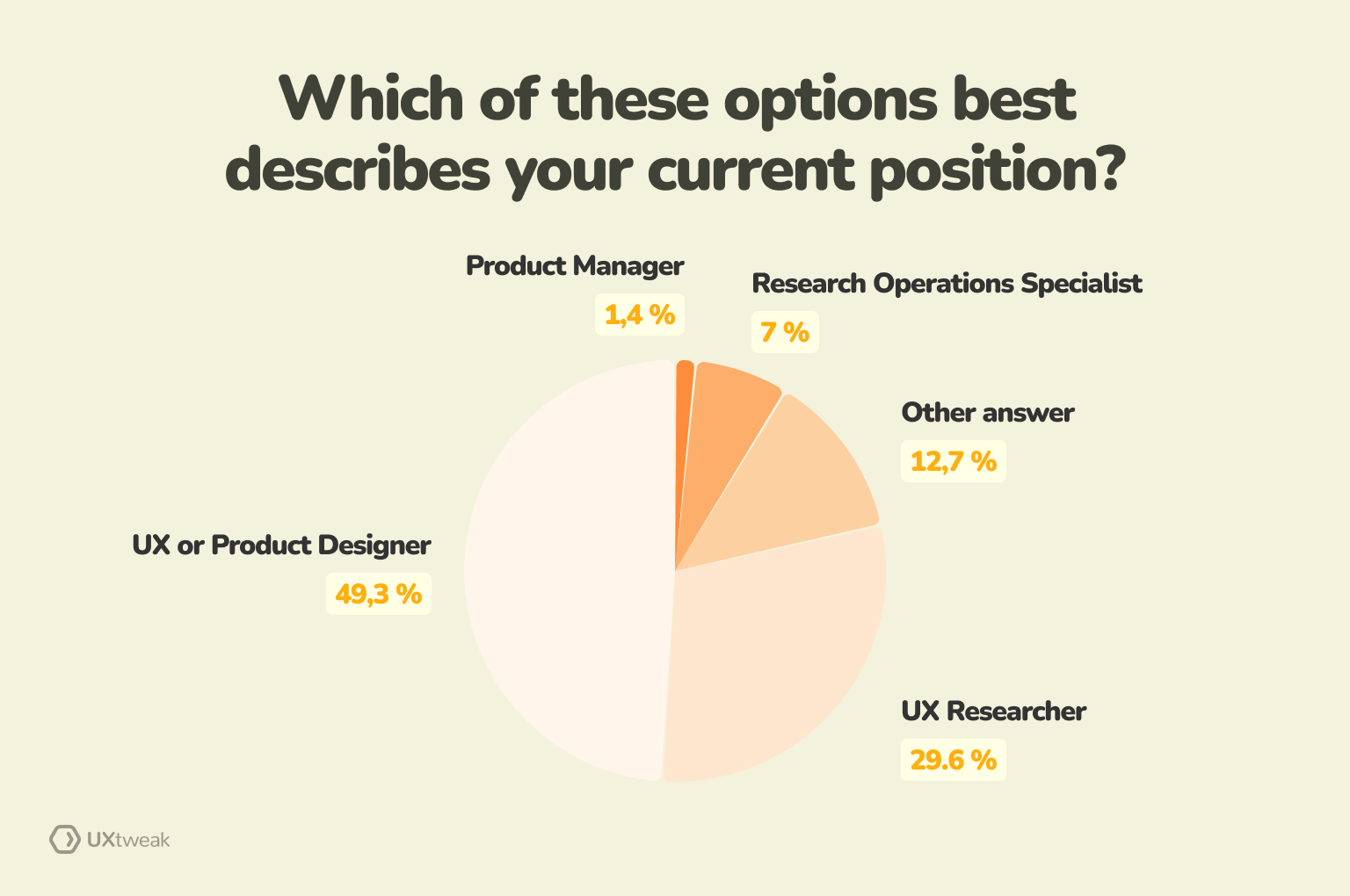
The majority of respondents have between 2 and 5 years of experience in the UX field, accounting for 42.3%. Those with 5-10 years of experience make up 26.8%, while 22.5% have over 10 years of experience. Only 8.5% of respondents are relatively new to the field, with less than 2 years of experience.
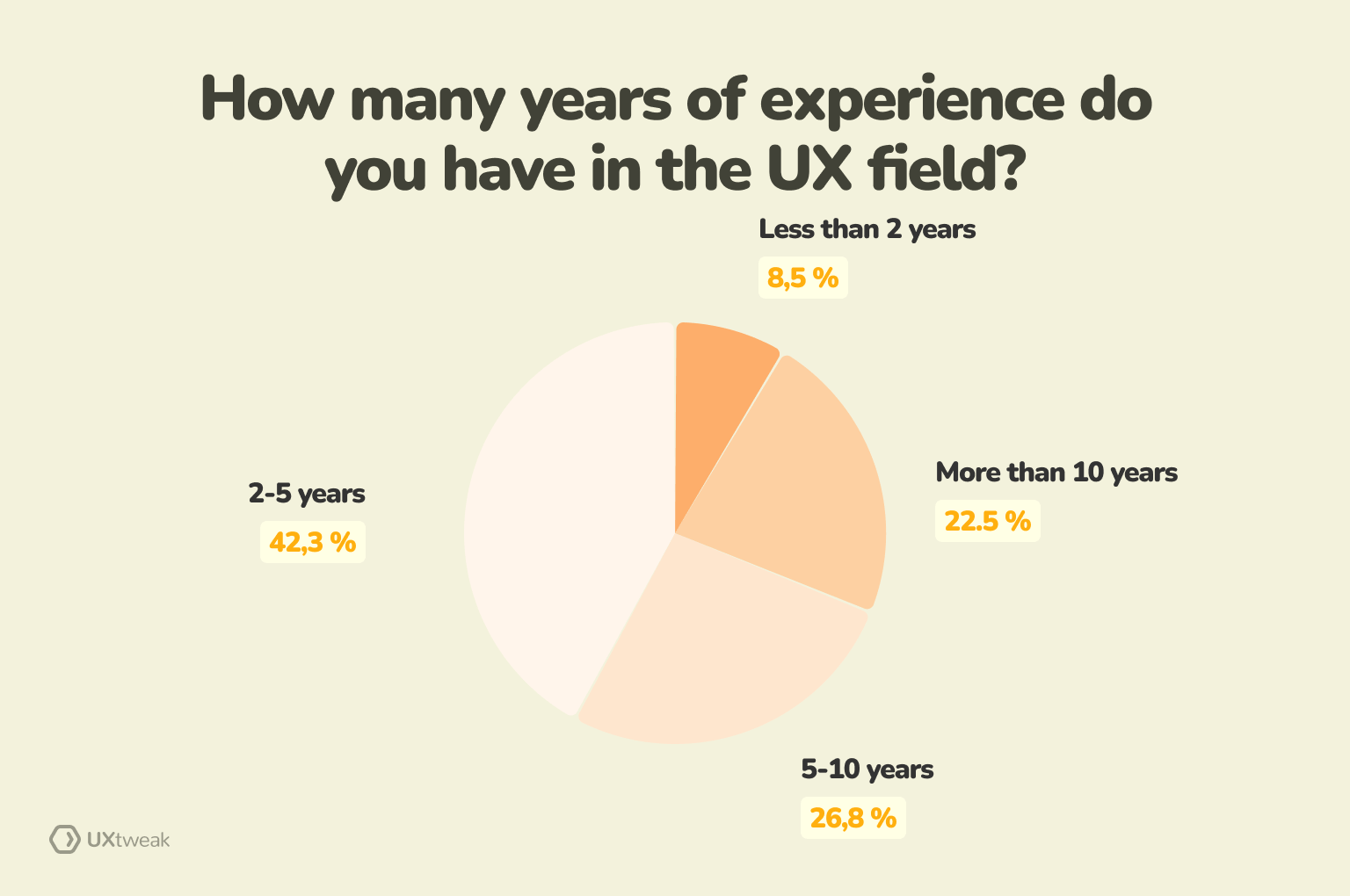
Most respondents work for corporations, making up 39.4% of the total. Startups are the next most common workplace at 23.9%, followed by agencies at 15.5%. Freelancers account for 11.3%, while smaller percentages work for non-profits (5.6%) and government (2.8%). A few respondents (1.4%) indicated they work in other types of organizations.

30.2% of our respondents work in organizations with 10 to 50 employees. Larger organizations with over 1000 employees account for 25.4% of respondents. Those in companies with 51 to 200 employees make up 19.0%, while 17.5% are in organizations with 201 to 1000 employees. A smaller group, 7.9%, work in organizations with fewer than 10 employees.
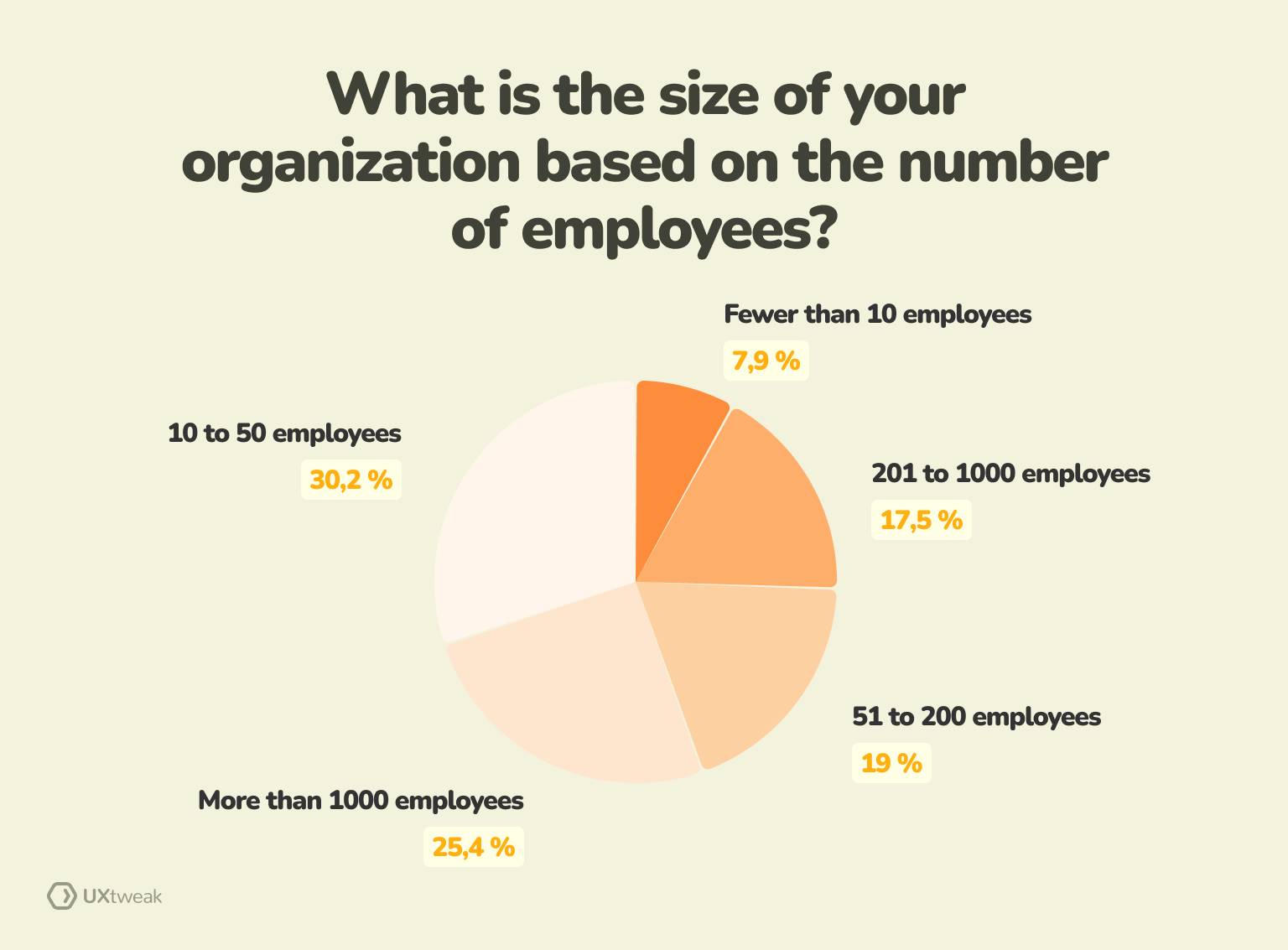
UXR Cheat-Sheet 🐝 : 8 Strategies for Dealing with Research Resistance
Download the Cheat Sheet 📥
8 actionable strategies from UX professionals to overcome stakeholder’s objections to research & secure buy-in
Get your free copy now ⬇️

Summing up
This survey shined the light on the challenges UX professionals face when pushing research through and the strategies they use to overcome them.
We hope that the collective wisdom above will help you engage stakeholders in your work and make research a significant part of your projects, not just a nice-to-have add-on.
And let’s finish it up with a short self-promo moment 😄
If you made it this far in this article, go check out UXtweak too! 🐝 We are an all-in-one research tool for improving usability of your digital products, from prototypes to production.
With UXtweak you can conduct user interviews, usability tests of websites, mobile apps and prototypes, card sorts and tree tests and tons of other research studies!
Try our new Live Interviews tool 🐝
Seamlessly schedule, recruit, conduct, and analyze your all user interviews.
➡️ Learn more about the feature and be the first to try it!
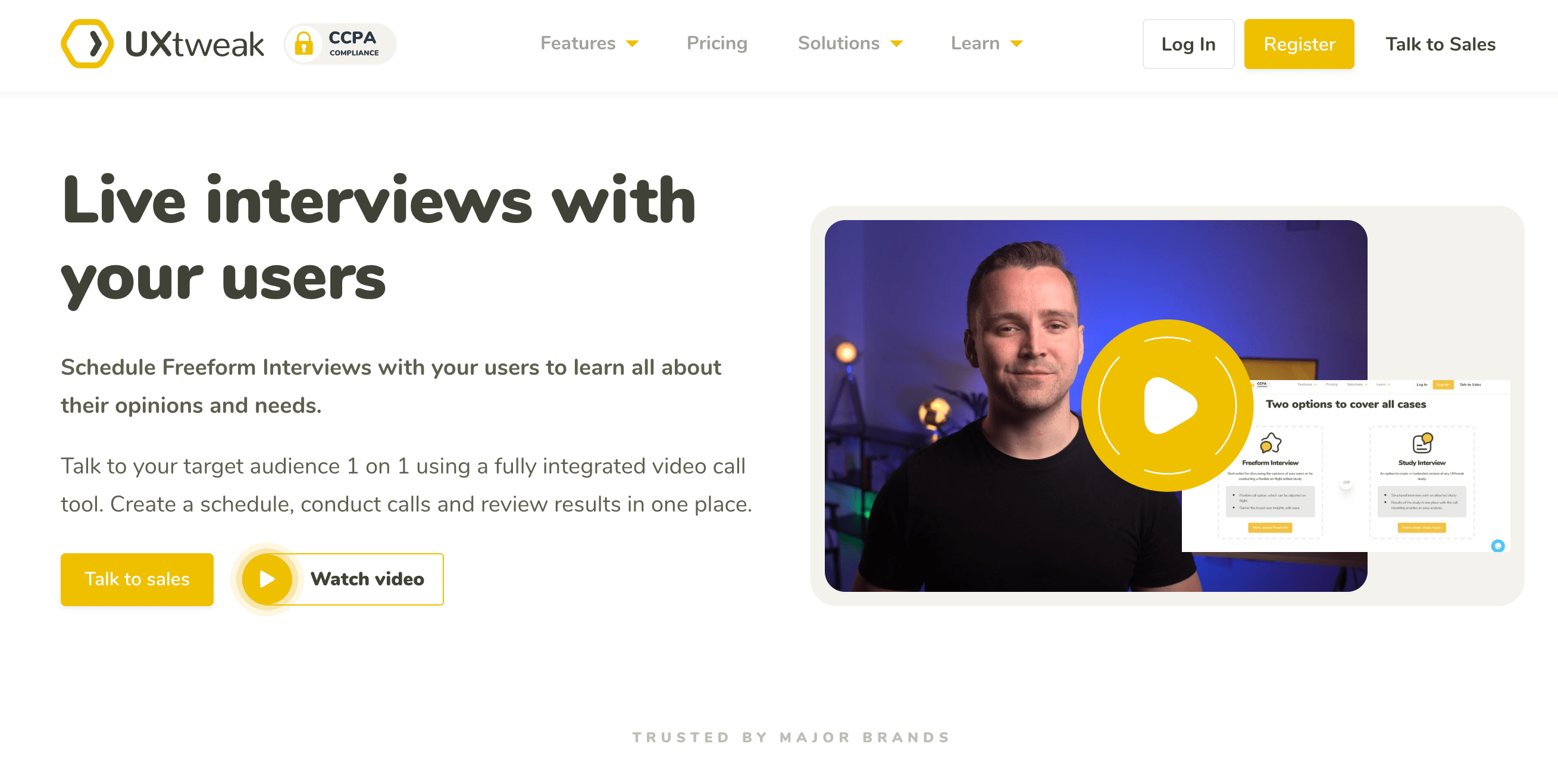




Now, we’ll dive into the survey itself and the insights from it. Use these jump links to skip right to the section you’re most interested in ⤵️